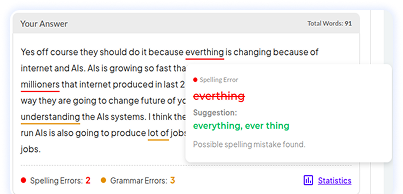If you’re planning to settle in Canada or pursue professional opportunities, understanding the CELPIP test is essential. This test evaluates your English proficiency in speaking, writing, listening, and reading. The exam is divided into four sections, and to score well, it’s essential to practice all of them. To help you get started, here’s an in-depth look at the CELPIP Speaking Test.
CELPIP Speaking Test Format:
Below is the format of the test along with a CELPIP speaking sample question and answer to help you understand the structure and response in depth.
Task 1: Giving Advice
This task is about giving advice or guidance to someone who needs help making a decision or getting ready for something. Your goal is to help someone either make a choice or prepare for an upcoming event, activity, or challenge.
- Prep Time: You have 30 seconds to plan what you’ll say.
- Speaking Time: You must speak for 90 seconds.
Key Strategies:
- Speak directly: Talk as if you’re giving advice to a friend—use “you” and keep it personal.
- Give three suggestions: Offer at least three helpful ideas.
- Add reasons or examples: Explain why each suggestion is useful with a reason or real-life example.
- Use transitions: Start each suggestion with phrases like “If I were you…” or “Another thing you could do is…”
- Be helpful and kind: Speak in a friendly and thoughtful way to show you care.
Sample Question With Answer:
Question:
Your friend, Sarah, is considering buying a car but is unsure whether to get a new one or a used one. She’s worried about costs, reliability, and long-term value. Give Sarah some advice about how she should decide and what she should consider.
Response:
Hi Sarah! I totally understand why this decision might feel a bit overwhelming, but I’ve got some suggestions that might help you out. First, if I were you, I would consider your budget carefully. A used car is usually much more affordable upfront, and you might even be able to pay for it without a loan. That could save you a lot in interest payments over time.
Another thing you could do is look into the reliability ratings of different car models. Some used cars have excellent reputations and last for years. If you choose a model known for durability, you can save money and still get a dependable vehicle.
One final thing is, think about how long you plan to keep the car. If you want something long-term and low maintenance, a new car might make more sense since it comes with a full warranty and fewer issues early on.
In the end, weigh the pros and cons based on your finances and your future plans. I know you’ll make a smart choice!
Take advantage of Gurully’s free mock test with instant AI-scoring and start your preparation now. 
Task 2: Talking about a Personal Experience
This task asks you to tell a short story about something that happened in the past. Your goal is to make it clear, detailed, and emotionally engaging for the listener.
- Prep Time: 30 seconds
- Speaking Time: 60 seconds
Key Strategies :
- Choose your story fast: Quickly pick a clear memory or situation you want to talk about.
- Make it up if needed: If you can’t think of a real event, create a believable story.
- Use past tense: Since it’s about the past, use verbs like went, saw, felt, etc.
- Add details: Describe what you saw, heard, or felt to make the story more vivid.
- Share your feelings: Help the listener connect with the story by expressing your emotions clearly.
CELPIP Sample Question With Answer:
Question:
Talk about a time when you overcame a challenge. You could describe something difficult you had to do at school, work, or in your personal life. What was the challenge, how did you overcome it, and how did you feel afterward?
Response:
A few years ago, I had to give a big presentation at work, and public speaking has always made me really nervous. The challenge was that I had to present in front of the entire management team, and I only had three days to prepare.
At first, I felt overwhelmed, but I decided to break the task into smaller steps. I wrote out a clear outline, practiced in front of the mirror, and even asked a friend to listen and give feedback.
When the day came, I was still nervous, but I took a deep breath and gave it my best. To my surprise, everything went smoothly, and a few managers even complimented me afterward. I felt proud, relieved, and much more confident.
Task 3: Describing a Scene
You will be shown an illustration. Your task is to describe what is happening in the image clearly and in detail.
- Preparation Time: 30 seconds
- Speaking Time: 60 seconds
Key Strategies:
- Start with a general statement: Begin by giving an overall idea of what the picture is about. This sets the context for your description.
- Focus on some details: Choose a few important elements in the image to describe. You don’t need to cover everything—just focus on what stands out.
- Build a picture: Speak in a way that helps the listener visualize the scene. Describe the setting, atmosphere, and layout of the image.
- Use descriptive words and phrases: Use vivid vocabulary to make your description more engaging. This helps convey emotions and actions more clearly.
- Describe people’s appearance, actions, and feelings: Talk about what the people look like, what they are doing, and how they might be feeling based on their expressions or body language.
Sample Question With Answer:
Question:
Describe what is happening in the picture below as clearly as you can. The person you are speaking to cannot see the image.

Response:
This picture shows a lovely afternoon in a park. In the front, a family is enjoying a picnic. The mother is handing food to her son, who looks happy, and the father is smiling while sitting on the blanket. There’s a picnic basket and some fruit beside them. In the background, two kids are having fun on the swings. They look excited and full of energy. A man in an orange shirt is jogging along the park path. He seems focused and is enjoying his run.
On the right side, an ice cream vendor is serving a young girl. She looks thrilled as she gets her cone, and the vendor is smiling back. The park is full of green trees, and the sky is bright and sunny. Everyone in the scene looks relaxed and happy, making it feel like a perfect day to be outside.
Task 4: Making Predictions
In this task you have to refer to the same illustration shown in Task 3. Based on what you observe, describe what you think is likely to happen next.
- Preparation Time: 30 seconds
- Speaking Time: 60 seconds
Key Stratigies :
- Be imaginative, but stay realistic: Your predictions should connect logically to what the people in the image are doing.
- Ask yourself: What are the people likely to do next? How might they feel afterward?
- Look closely at the surroundings: Pay attention to people, objects, and settings in the picture to help you build a thoughtful and believable scenario.
Sample Question With Answer:
Question:
Describe some things that are happening in the picture below as well as you can. The person you are speaking with cannot see the image.

Response:
Looking at this scene, I think several things might happen next. The family sitting on the picnic blanket will probably continue enjoying their food and maybe play a game together afterward, like catch or frisbee.
The kids on the swings look very energetic, so I imagine they’ll soon run off to explore other parts of the park, maybe the slide or the climbing area if there’s one nearby. The man jogging might take a break and grab a bottle of water or even stop at the ice cream cart for a treat.
As for the little girl getting ice cream, she’ll probably walk back to her family or friends to enjoy it in the shade. The vendor might start serving more children who are waiting in line. Overall, it looks like the fun and relaxing atmosphere in the park will continue, with people enjoying the weather and each other’s company.
Task 5: Comparing and Persuading
Part 1:
You will be given two choices, from which you must select one. In this part, you will not speak.
- Preparation Time: 60 Seconds
- Speaking Time: No Speaking time.
Part 2:
You will speak for 60 seconds to convince someone that your chosen option is better than the one they selected.
- Preparation Time: 60 Seconds
- Speaking Time: 60 seconds
Key Strategies:
Part 1:
- Carefully read and understand the situation presented: Fully comprehend the context to ensure you’re aware of the key details of each option.
- Compare the features and benefits of both options: Evaluate the advantages of each to determine which one better aligns with your preferences.
- Decide quickly which option you prefer and feel more confident discussing: Make a quick, confident choice based on the comparison, focusing on the option that suits you best.
Part 2:
- Read and understand the other person’s choice: Carefully analyze the alternative option presented to understand the reasons behind it.
- Plan strong reasons and supporting details to explain why your option is better: Identify compelling arguments and examples that highlight why your choice is superior.
- Use clear, persuasive language and expand on the information provided: Explain your reasoning clearly and confidently, adding details to strengthen your argument.
Sample Question With Answer
Part 1 (Reading Only – No Speaking Required):
You are planning to move to a new place with a close friend. You have two options:
Option A: Move to the countryside. It is quiet, surrounded by nature, and offers a peaceful lifestyle. There is little traffic, fresh air, and open space for children to play.
Option B: Move to the city. It is full of job opportunities, cultural events, and social activities. Public transport is easily available, and everything is within walking distance.
Your friend prefers Option B, but you prefer Option A.
Option A:

Option B:

Part 2 (Speaking – 60 seconds):
Persuade your friend that Option A, moving to the countryside, is a better choice. Explain your reasons and try to convince your friend to agree with you.
Response :
Hey! I know you’re leaning towards moving to the city, and I get that—it’s full of energy, opportunity, and things to do. But honestly, I think the countryside would be a much better choice for us. Just take a look at the first image. It shows a calm, scenic environment with wide open spaces, greenery, and a relaxed pace of life. There’s a clear path, clean air, and hardly any noise or traffic. People are enjoying a peaceful walk, and it’s perfect for raising a family or simply unwinding after work.
In contrast, the second image shows the city—crowded streets, tons of traffic, and people rushing around in suits. While it looks exciting, it also feels really hectic and stressful. Living there might mean long commutes, constant noise, and very little personal space. I believe in the countryside, we’ll enjoy a healthier lifestyle, better mental well-being, and a stronger sense of community.
So, even if we give up a few conveniences, I think the benefits of country life far outweigh the drawbacks. Let’s make a choice that gives us more peace and quality time.
Task 6: Dealing with a Difficult Situation
In this task, you need to explain a decision you’ve made to a friend, family member, acquaintance, or customer.
- Preparation Time: 60 seconds
- Speaking Time: 60 seconds
Key Strategies:
- Address the person directly: Speak as if you are talking to them in real life—use their name or role to personalize your message.
- Maintain a respectful and polite tone: Use courteous language to show you value their perspective, even if they may not agree.
- Be firm yet considerate in your delivery: Stand by your decision confidently, but show understanding of the other person’s feelings or concerns.
- Clearly describe the issue or situation: Give enough background so the listener understands what led to the decision.
- State the decision you’ve made: Be clear and specific about what you have decided—avoid vague or uncertain language.
- Support your decision with clear and logical reasons: Explain why the decision was necessary, using facts or reasoning to strengthen your point.
Sample Question With Answer:
Situation:
You are working as a customer service representative at a mobile phone store. A customer comes in very upset because their phone stopped working just three days after they bought it. However, the phone has a cracked screen, and your company policy clearly states that physical damage voids the warranty. Your manager refuses to offer a refund or exchange. The customer insists the crack happened because the screen is too fragile and says the product is defective.
Choose ONE:
EITHER
→ Talk to your manager. Explain why the phone should be exchanged or refunded.
OR
→ Talk to the customer. Explain why the phone cannot be refunded or exchanged.
Response (Option: Talk to your manager):
Hi, I wanted to talk to you about the customer who came in with the broken phone. I understand that our policy doesn’t allow refunds or exchanges when a product is physically damaged. However, in this case, the customer claims the screen cracked with very little impact, just a few days after purchase. He believes it’s a product defect, not user damage.
To maintain our store’s reputation and customer trust, I think it might be a good idea to offer a one-time exchange or partial refund. The customer is very upset, and if we don’t make some effort to resolve this fairly, it might lead to negative reviews or complaints. I believe an exception here could help us build goodwill and retain a loyal customer.
Task 7: Expressing Opinions
The task requires you to express your opinion in response to a “Do you think…?” question. You should provide clear reasoning and examples to support your viewpoint.
- Preparation Time: 30 seconds
- Speaking Time: 90 seconds
Key Strategies:
- Understand the question thoroughly: Ensure that your response directly addresses the topic.
- Decide on your stance quickly: Choose whether you agree or disagree, and be clear about your position.
- Provide three supporting reasons: Give at least three solid reasons to back up your opinion.
- Elaborate with specific examples: Support each reason with detailed and relevant examples to strengthen your argument.
- Organize your response clearly: Present your ideas in a logical order, using transitions to guide the listener through your points.
Sample Question With Answer:
Question:
Do you think schools should eliminate traditional exams and focus more on projects and presentations? Explain your reasons.
Answer:
Yes, I do believe that schools should reduce traditional exams and focus more on projects and presentations. First of all, traditional exams often create unnecessary pressure and anxiety among students. Many students who are bright and creative underperform simply because they struggle with timed tests.
Secondly, projects and presentations allow students to develop real-world skills like communication, collaboration, and critical thinking. These are much more valuable in everyday life and in most careers than just memorizing facts.
Lastly, practical tasks encourage deeper learning. When students work on a project, they have to apply their knowledge, research thoroughly, and think independently. This approach promotes long-term understanding rather than short-term memorization for exams.
In conclusion, shifting away from traditional exams can help students enjoy learning more and become better prepared for life beyond school.
Task 8: Describing an Unusual Situation
In this task you have to explain the details of an unusual item or situation from a picture to someone who is unable to see it. Focus on key features and use clear, descriptive language to convey the image.
- Preparation Time: 30 seconds
- Speaking Time: 60 seconds
Key Strategies:
- Set the context of the conversation: Begin by introducing the role-play scenario, such as “Hi, Jill…”.
- Highlight the unique features of the image: Describe the aspects of the picture that stand out or are unusual.
- Focus on what you can clearly describe: Concentrate on the details you can explain well, making them vivid for the listener.
- Use familiar words to express meaning: If you lack specific vocabulary, create descriptive phrases using familiar terms.
- Conclude the conversation appropriately: Wrap up your description and end the call politely.
Sample Question With Answer:
Question:
Your cousin asked you to pick him up from a coffee shop you’ve never been to before. You arrived at the address, but something seems odd. The café looks like it’s under renovation, and there’s no one inside. Call your cousin. Describe what you see around you and ask if you’re in the right place.

Answer:
Hi, Sam! I’m at the address you gave me, but I think something’s not right. The place looks totally empty. The windows are covered with newspaper, and there’s a sign on the door that says “Under Renovation.” I don’t see anyone inside, and all the chairs are stacked up against the wall.
There’s a bakery just across the street called “Sweet Crumbs,” and to my left, there’s a bus stop with a bright yellow bench. I can also see a tall blue building with glass windows right behind the café.
Am I in the right place? Did you mean the coffee shop next to this one? Let me know quickly, because I’m just standing outside and it looks like this place has been closed for a while.
Enhance your CELPIP Speaking skills with Gurully. We offer full-length CELPIP Speaking practice tests with accurate AI scoring. Our real-time exam simulation helps you get familiar with the actual CELPIP Speaking Test format. Practice a wide range of CELPIP speaking questions on Gurully and improve your performance. Get ready with Gurully and boost your chances of scoring high.
Mistakes To Avoid in CELPIP Speaking Test
- Speaking too fast or too slowly, which affects clarity and fluency.
- Going off-topic and not directly answering the prompt.
- Using very basic vocabulary and repeating the same words.
- Pausing too often or staying silent due to poor time management.
- Ignoring structure, such as not having a clear beginning, middle, and end.
Conclusion:
CELPIP Speaking Test requires a deep understanding of each task type, strategic preparation, and regular practice. Every task evaluates specific communication skills important for real-life interaction in Canada. You can boost your confidence and performance by understanding the speaking section and practicing with realistic sample questions and responses. You can practice more of these question types in Celpip mock test. Our online mock test provides real-time exam simulation with instant AI scoring. Start practicing today with Gurully and take a confident step toward your CELPIP success.
Along with CELPIP mock test, Gurully also provides a PTE Mock Test free to help you prepare effectively for the PTE exam with real-time AI scoring.
FAQ:
How do you pass the CELPIP speaking test?
What should I avoid in CELPIP speaking?
Is 7 a good score in CELPIP?
What is 28 out of 38 in CELPIP Reading?
Is CELPIP harder than IELTS?
Also Read:
- Decoding the CELPIP Score Chart – Set Yourself Up for 2025 Success
- Know Everything about CELPIP Test Booking, Registration, Scoring, Fees & Eligibility For 2025
- CELPIP Vs IELTS – Which English Proficiency Test is right for you?
- Tips for Efficient Time Management during your CELPIP Test






